9.12.11 Mushroom Magic
And they say lightning doesn't strike twice. Either it's beginner's luck or I am some sort of idiot savant of mushroom foraging, but just two days after finding the enormous
chicken mushroom, I came across this extraordinary hen-of-the-woods! Once again, I was driving, this time coming back from my weekly shopping trip to the farm. I simply glanced out the window and there, recessed in the woods, at the base of a large, rotting oak stump and illuminated by a single shaft of dappled sunlight, with this gorgeous, ruffled mound.
Surely not, I thought to myself. And then screeched to the side of the road and plunged into the forest. I was cackling like a madwoman as I brought this into the house, as drunk with victory as a conquering Roman. And then, this morning, up for my constitutional at 7am, I came across yet another hen-of-the woods! Not as big as the first one, but still 5 gloriously fresh pounds of it! And some chanterelles, to boot!
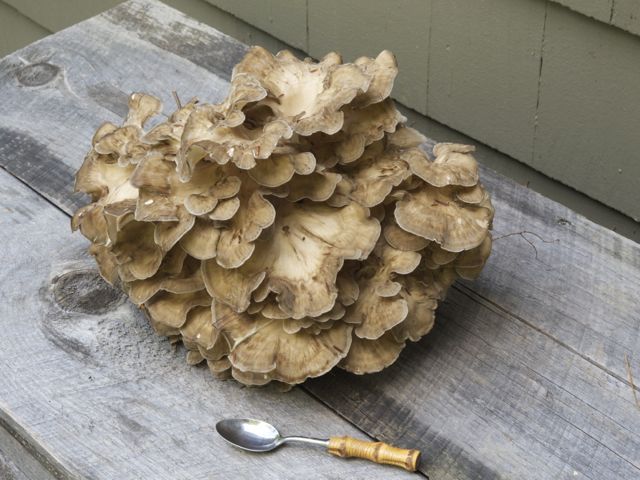
the second hen-of-the-woods haul
G said I needed to add something for scale in the photo. This baby is about the size of a very large watermelon.
Grifola frondosa, also known by its Japanese name of maitake, is a polypore mushroom
that grows in clusters at the base of trees, particularly oaks. This one was growing from the base of an old oak stump. It's one of the choicest wild edibles, with a rich yet delicate flavor and a smooth, meaty texture.

it has gorgeous ruffles in varying shades of buff, tan and cream
Maitake is rich in minerals (potassium, calcium and magnesium), vitamins, fiber and amino acids. It has long been used medicinally in Asia, and current research now indicates that it enhances immune function and regulates blood pressure and insulin levels.
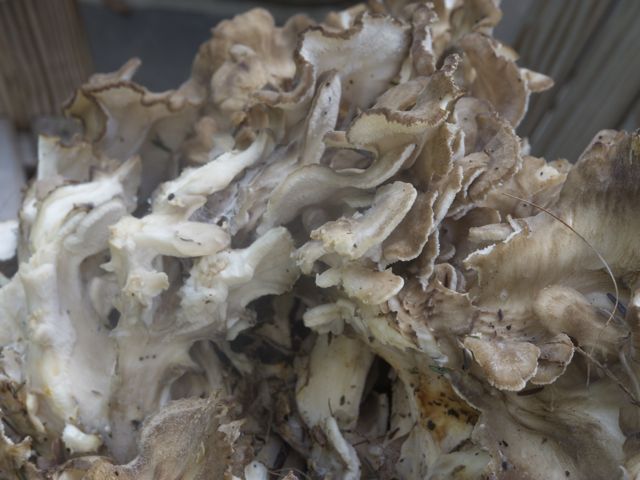
the mushroom often grows around pine needles and small branches
Cleaning the enormous one was a bit of a process, as the base was full of pine needles, moss and dirt, and there were plenty of spiders and other bugs living inside. We brought some of it to our friends at Beaver Dam last night, along with some chicken mushroom and some of Tomo's foraged black chanterelles, and they just happened to have freshly-made ricotta gnocchi waiting for us! It was a match made in culinary heaven.
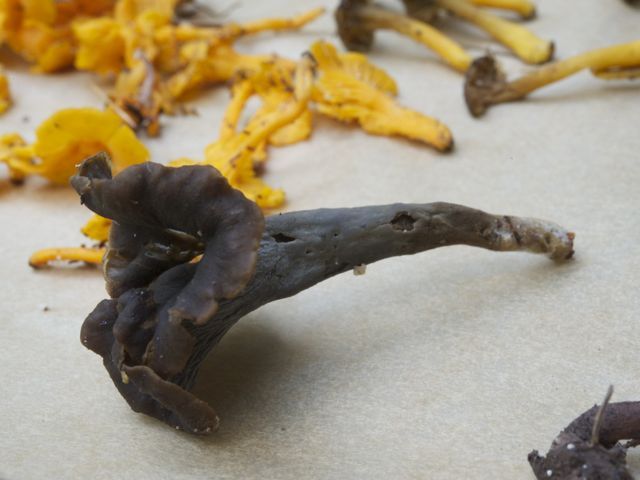
i was extremely thrilled to find even one black chanterelle (aka black trumpet)

i'm still hoping to find a huge patch of these prized yellowfoot chanterelles
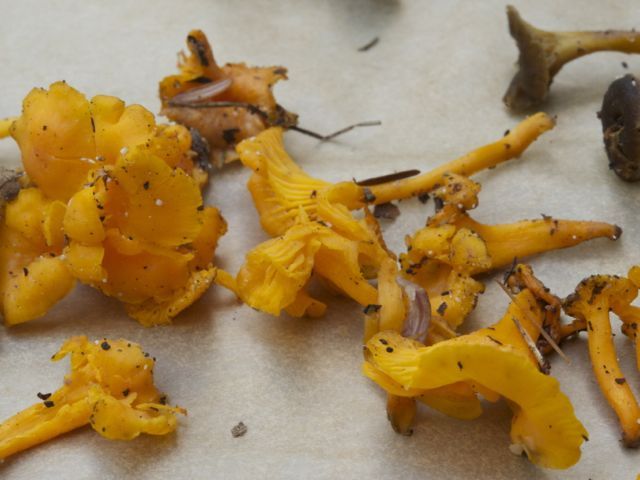
not to mention more of these glorious golden ones
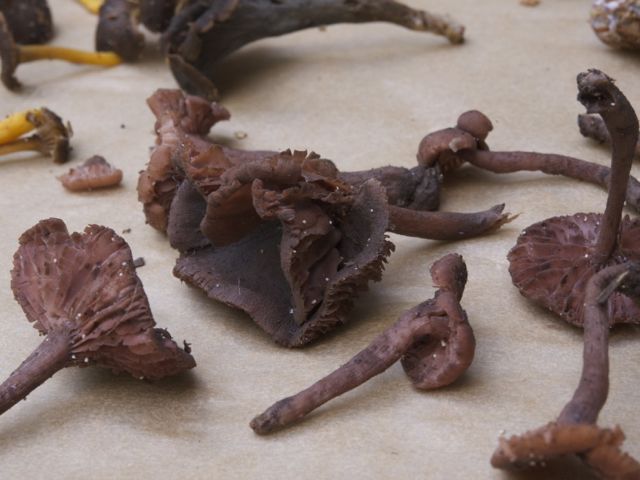
these also look like chanterelles, I can't find this color mentioned anywhere
If you ever get tired of eating your wild mushrooms cooked with butter and cream and spooned over pasta, gnocchi, toast or polenta, try Thomas Keller's riff on a classic Basque recipe that calls for sizzling and then storing the mushrooms in good olive oil. Eat them with cheese, with roast chicken or mixed into a salad.
Mushroom Conserva
from Thomas Keller's Ad Hoc at Home
-
— 1 sprig rosemary
-
— 1 teaspoon piment d'Espelette
-
— 4 sprigs thyme
-
— 2 bay leaves
-
— 2 cups extra virgin olive oil
-
— 2 pounds wild mushrooms, as assortment of porcini, morels, chanterelles, hen-of-the-woods, etc. (or substitute criminis)
-
— 3 tablespoons sherry vinegr
-
— sea salt & freshly cracked black pepper
Just before cooking, rinse the mushrooms as necessary to remove any dirt. Remove any stems that are tough, such as the stems of shiitake mushrooms, and discard or set aside for another use (vegetable stock). Trim the end of other stems as well as any bruised areas.
Cut the mushrooms into pieces. The size and shape will vary with the variety of the mushroom. Small mushrooms can be left whole, larger mushrooms can be cut into chunks or slices. Some mushrooms with meaty stems, such as porcini or trumpet mushrooms, can be cut lengthwise in half.
Use the tip of a paring knife to score the inside of the stem in a crosshatch pattern. This will enable the marinade to penetrate the stem. The pieces of mushroom will shrink as they cook, but the finished pieces should not be larger than one bite. You should have about 1.5 pounds (10 cups) of trimmed mushrooms.
Combine the olive oil, bay leaves, thyme sprigs, rosemary and piment d'Espelette in a large, wide saucepan over medium to medium-high heat until the oil reaches 170º (it may be necessary to tilt the pot and pool the oil to get a correct reading on the thermometer). Add the mushrooms to the pot and gently turn them in the oil. When the oil reaches 170º again, adjust the heat as necessary to retain the temperature and cook for 5 minutes, gently turning the mushrooms from time to time. The mushrooms will not initially be submerged in the oil, but will wilt as they steep.
Remove from the heat, stir in the vinegar, add salt and pepper to taste, and let the mushrooms steep in the oil for 45 minutes.
Transfer the mushrooms, oil and herbs to a covered storage container; the mushrooms should be covered by the oil. The conserva will keep for up to 1 month in the refrigerator. Serve hot or at room temperature.
 Download Recipe
Download Recipe
 Download Recipe
Download Recipe






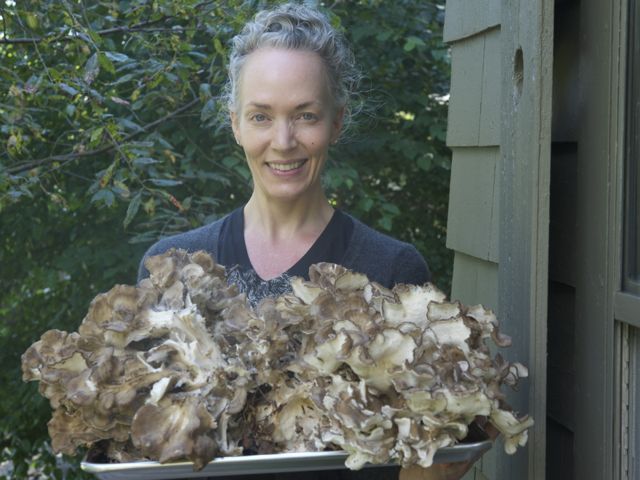







9 Comments
NanLisa! It means "when in doubt, throw it out!"